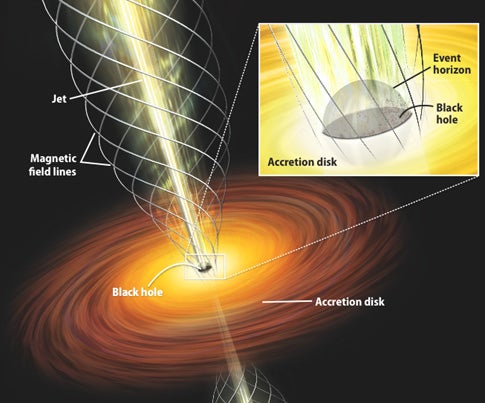The size of the event horizon depends linearly on the black hole’s mass. For a black hole the mass of our Sun, that distance (as measured from the black hole’s center) is only 1.9 miles (3 kilometers). So, if you were transported to within that distance, say 1.2 miles (2 km) of such a black hole’s center, you would be swallowed by it.
Astronomers divide black holes into two groups: stellar-mass black holes (with masses between 1 and 10 times our Sun’s) and supermassive black holes (with masses millions to billions times that of our Sun). Quasars are young galaxies with supermassive black holes characterized by extreme luminosities — on the order of trillions of times that of our Sun.
The light you see is created when rotating material moves toward the black hole’s center. The gas and dust follow a path similar to one water takes when you pull the plug from a drain. The water spirals toward the drain and, the closer it gets to the center, the faster it rotates. The material forms a disk around the black hole. Friction heats the material and makes it shine brightly. This is one way astronomers can observe black holes: by their effect on surrounding material.
Astronomers have observed many quasars firing off jets at nearly the speed of light. These jets are aligned 90° to the black hole’s accretion disk, and the material in the jet is launched outside the event horizon. The formation processes of these jets are not completely understood, but astronomers believe strong magnetic fields aligned 90° to the accretion disk channel the jets. Channeling the ejected material outside the event horizon requires powerful forces, like those exerted by strong magnetic fields.
Our own Milky Way harbors a central black hole with a mass of about 3 million Suns. Astronomers, however, haven’t detected jets there, which implies the black hole is starved. If little mass reaches the black hole, not much can be ejected. — MARYAM MODJAZ, HARVARD UNIVERSITY, CAMBRIDGE, MASSACHUSETTS










